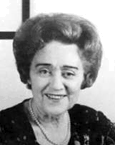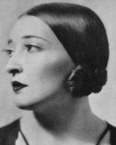Ten years ago, a large number of Clara’s friends, family members and admirers gathered at Steinway Hall, a few blocks away from her 57th street apartment in New York, to celebrate her 90th birthday. Clara had been planning the party for a few years, and when she realized she wouldn’t live long enough to be there herself, she left detailed instructions, and willed funds so her family could proceed as she had envisioned. She even made up a guest list so we wouldn’t forget anybody she wanted to be there. It was indeed a memorable event, with personal reminiscences, music (of course), and Clara’s strong presence deeply felt.
Well, now it’s time to mark Clara’s centennial, and what a joy it is to report that her spirit is still with us. In fact, her influence is expanding, with more and more young music lovers taking inspiration from her work, and her unique place in musical history ever more secure.
Those of you who know only her music can’t share our wonderful memories of Clara at home, surrounded by art works, and the two theremins that stood as sentinels at opposite ends of the living room. The bright color red that splashed through her wardrobe perfectly matched her cheery personality, and we recall her warm laughter as she poured tea for any and all visitors. She was a lively talker, with a ready fount of stories, but an equally good listener, with a genuine interest in the other people’s lives and accomplishments.
• Case in point: Dalit Warshaw, the noted composer, teacher, pianist and thereminist, who met Clara as a child of six, took lessons from her as a teenager, and at Clara’s death, inherited her custom-made (by Lev Termen himself) instrument. “As both teacher and friend,” Dalit says, “she continued to be one of the more potent inspirational figures in my life, musically and personally.”
Dalit’s relationship with Clara is recounted in a warm and affectionate memoir she wrote for the Julliard School Journal; you can find it at http://www.juilliard.edu/journal/2010-2011/1103/articles/theremin.php and her new CD, “Invocations” (Troy 1238) includes two original compositions played on Clara’s theremin. “The recording is a centennial tribute to Clara,” Dalit says, “and by playing the piano in addition to the theremin, I sought to pay homage not only to Clara, but also to her sister, Nadia Reisenberg, who was her main partner during performances and recordings.”
• Lydia Kavina and Sergey Teterin have helped organize an international concert dedicated to Clara’s centennial, Friday, March 18 at the Frants Gallery in New York City. You’ll find more specifics at http://www.frantsgallery.com For reasons unknown, Lydia was denied a visa to attend in person, but she will speak to the audience on line from England. Other participants will include Dorit Chrysler, Olivia Mattis and members of the St. Petersburg and New York Theremin Societies, with Dalit Warshaw, Albert Glinsky and members of Clara’s family also in attendance.
• A few days ago, Kristjan Saag marked the centennial by featuring two of Clara and Nadia’s recordings on his Channel 2 “Rendezvous” programme on Swedish Radio. “I’ve been playing the CD with great pleasure,” Kristjan writes, “and to see some of the videos on YouTube is incredible.” The broadcast can be heard on line as streaming audio through the end of the month at http://www.sverigesradio.se/p2/rendezvous
Other Notes in Brief:
• John Hoge, a frequent contributor to the Theremin World website, continues his efforts on behalf of Clara’s legacy. “How can I not honor someone who laid the foundation for the most important part of my life,” he writes;”I just wish I could do more.” John also asked my son Steve to write a short piece for the centennial, which should be posted shortly (if it isn’t already) at http://www.thereminworld.com/article.asp?id=39
• Photos of Clara and Lev Termen were used in an educational project for Scholastic Publishing, called “Science Behind the Scenes.”
• Sara Blackwood writes from the Musical Instrument Museum (MIM) in Phoenix, AZ to say “We are so thankful to have Clara represented in our exhibit on electronic music.” More details: http://www.themim.org/
And in the It’s Never Too Late to Learn Department:
• Jack Crawford, doing research on composer Joseph Achron, wrote to ask about the arrangement Clara used for her performance of the “Hebrew Melody.” I assumed it was the original violin part, but Jack probed further, contacting Samuel Zerin, President of the Achron Society, who says that Clara’s version “appears to be based on Achron’s vocal version of the piece (Carl Fischer, 1928), since her cadenza exactly matches that in the vocal edition, omitting several transition measures after the cadenza that appear only in the violin version.”
• David McGill, taking frequent time out from his day job as principal bassoonist of the Chicago Symphony to work on a forthcoming biography of Clara, has also unearthed all sorts of facts and figures we hadn’t known about before. One intriguing note is that Clara actually celebrated her first six or seven birthdays on February 24th, because the old-style “Julian” calendar was used in Russia until 1918. Only after they arrived in America, did Clara and the others in the family update their birthdays to conform with the western calendar.
Oh well, who’s counting?
A few additional fascinations from David’s research: Clara and her father Aaron became American citizens on May 23, 1927; her Guadagnini violin was purchased from Wurlitzer for $4,500 on November 28, 1930; the June, 1932 issue of Mechanics Illustrated has a picture of Clara playing the ‘theremin-cello’, sitting next to Lev Termen.
Go, David! Can’t wait for the book to come out, we hope before the end of the centennial year. It will not only be the first fully authenticated biography of Clara and her remarkable family, but the only study carefully codifying her movements and fingering techniques.
Nadia, Briefly
Understandably, Clara’s centennial gives her pride of place in our updatings this time, but there’s news on the Nadia front too.
• Sony Music Group is issuing the 10th edition of Roger Kamien’s “Music, An Appreciation,” in a download version that includes NR’s beautiful recording of Chopin’s Nocturne in E-flat, Op. 9 #2. As a teenager, Roger was one of NR’s prize students.
• Andy Lanset, the indefatigable archivist at WNYC, and now WQXR, found a listing from July of 1948, indicating that NR would open a special summer series of live recitals while the WQXR String Quartet was on vacation. She played with the cellist Felix Salmond on July 11, just three days before her 44th birthday. Another superb duo – violinist Caroll Glenn and pianist Eugene List – was featured later in the Sunday evening series.
• A few months ago, The New York Philharmonic launched an extraordinary project that will eventually make available 8 million pages of documents in digital form. The first stage covers the years 1943 through 1970, so by going to nyphil.org, and thence to digitalarchives, you can see the actual programs from NR’s appearances with the Philharmonic under Artur Rodzinski in Prokofiev’s Piano Concerto #3 (4/13 and 4/14/44), and a brilliant piece that nobody seems to play any more, Kabalevsky’s Piano Concerto #2 (1/11, 12 and 14/45). There is a program from 5/18/46 indicating that NR was soloist in the Rimsky-Korsakov Concerto with “members of the New York Philharmonic” under Constantin Bakaleinikoff, and she is also listed on the artist committee for Steinway’s Centenary celebration in 1953.
• As always, your thoughts, comments, ideas, suggestions (and donations) are most welcome, and can be sent directly to the Nadia Reisenberg / Clara Rockmore Foundation at 5 Tavano Road, Ossining NY 10562 or via e-mail: rsher762@aol.com


